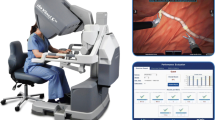Abstract
Background
Current physical laparoscopic surgical simulators provide training only for static tasks, which do not develop the more advanced hand–eye coordination skills needed to navigate the dynamic surgical environment. A novel dynamic minimally invasive training environment (DynaMITE) was developed to address this need. This study aimed to evaluate further the utility of the system as a training and skill assessment tool. Two studies were performed with a second-generation design. The authors hypothesized that the dynamic task environment would be challenging to novices and would differentiate experienced surgeons from the inexperienced by emphasising the dynamic skills gained through surgical experience.
Methods
The participants in the first study were 42 novice and experienced surgeons attending the Society of American Gastrointestinal and Endoscopic Surgeons (SAGES) 2007 Learning Center, whereas the second controlled laboratory study had 16 participants (5 novices and 11 experienced surgeons). The participants performed two tasks: an aiming task and an object manipulation task. Both tasks were positioned on a dynamic platform that moved in five different trajectories.
Results
The subjective feedback from the surgeons at the SAGES Learning Center was positive. The results from the controlled study showed significant performance deterioration in the fast diagonal task compared with the task of aiming and manipulating in the static environment for both experience groups but no performance differences between the groups.
Conclusions
Dynamic tasks are challenging, and surgeons need to be trained specifically for these tasks. The DynaMITE system can provide training benefits for dynamic skill development, even for expert surgeons who may have had no opportunity to gain these skills through their surgical practice.











Similar content being viewed by others
References
Soper NJ, Brunt LM, Derbl K (1994) Laparoscopic general surgery. N Engl J Med 330:409–419
Mais V, Ajossa S, Guerriero S, Mascia M, Solla E, Melis GB (1996) Laparoscopic versus abdominal myomectomy: a prospective, randomized trial to evaluate benefits in early outcome. Am J Obstet Gynecol 174:654–658
Targarona EM, Marco C, Balague C, Rodríguez J, Cugat E, Hoyuela C, Veloso E, Trias M (1998) How, when, and why bile duct injury occurs: a comparison between open and laparoscopic cholecystectomy. Surg Endosc 12:322–326
Shimotsu RT, Cao CGL (2007) The effect of color-contrasting shadows on a dynamic 3-D laparoscopic surgical task. IEEE Trans Syst Man Cybernetics A 37:1047–1053
Picod G, Jambon AC, Vinatier D, Dubois P (2005) What can the operator actually feel when performing a laparoscopy? Surg Endosc 19:95–100
Nicolaou M, James A, Lo BP, Darzi A, Yang GZ (2005) Invisible shadow for navigation and planning in minimal invasive surgery. Med Image Comput Comput Assist Interv Int Conf Med Image Comput Comput Assist Interv 8(Pt 2):25–32
Hanna GB, Cresswell AB, Cuschieri A (2002) Shadow depth cues and endoscopic performance. Arch Surg 137:1166–1169
Andreatta PB, Woodrum DT, Birkmeyer JD, Yellamanchilli RK, Doherty GM, Gauger PG, Minter RM (2006) Laparoscopic skills are improved with LapMentor training: results of a randomized, double-blinded study. Ann Surg 243:854–860
Hyltander A, Liljegren E, Rhodin H, Lonroth H (2002) The transfer of basic skills learned in a laparoscopic simulator to the operating room. Surg Endosc 16:1324–1328
Hamilton EC, Scott DJ, Fleming JB, Rege RV, Laycock R, Bergen PC, Tesfay ST, Jones DB (2002) Comparison of video trainer and virtual reality training systems on acquisition of laparoscopic skills. Surg Endosc 16:406–411
Ali MR, Mowery Y, Kaplan B, DeMaria EJ (2002) Training the novice in laparoscopy. Surg Endosc 16:1732–1736
Bell AK, Saide B, Johanas JT, Leisk GG, Cao CGL, Schwaitzberg SD (2007) Innovative Dynamic Minimally Invasive Training Environment (DynaMITE). Surg Innov 14:217–224
Schmidt RA (1982) Motor control and learning: a behavioral emphasis. Human Kinetics Publishers, Champaign IL
Lordahl DS, Archer J (1958) Transfer effects on a rotary pursuit task as a function of first-task difficulty. J Exp Psychol 56:421–426
Acknowledgment
The authors thank the subjects for their valuable time in the studies and their feedback on the DynaMITE.
Author information
Authors and Affiliations
Corresponding author
Rights and permissions
About this article
Cite this article
Bell, A.K., Zhou, M., Schwaitzberg, S.D. et al. Using a dynamic training environment to acquire laparoscopic surgery skill. Surg Endosc 23, 2356–2363 (2009). https://doi.org/10.1007/s00464-009-0346-1
Received:
Revised:
Accepted:
Published:
Issue Date:
DOI: https://doi.org/10.1007/s00464-009-0346-1




